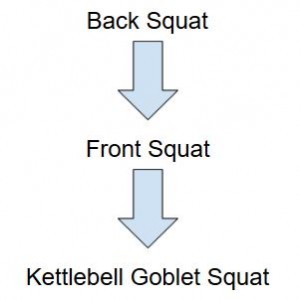Regressions and Progressions
Introduction
 Team training can be challenging. There are a variety of factors that have to be taken into account when working with large groups and sometimes it can be a bit overwhelming.
Team training can be challenging. There are a variety of factors that have to be taken into account when working with large groups and sometimes it can be a bit overwhelming.
When programming for a diverse population, it is important to account for the various needs of the group in order to ensure success. Injury history, physiological age and ability level are just a few of the factors that need to be considered when developing your training programs.
These factors become even more important when you will be working with the same group for an extended amount of time. This will be a 2-part blog series that will explain this process.
This blog post will focus primarily on what must initially be considered in order to program for the long-term effectively. The second post will focus on specific examples of progressions and regressions and how to utilize those in LTAD programming.
#1 Backward Design
It is important to begin with the end in mind. As the coach, you must determine what your top tier exercises will look like in your program. A top tier exercise should be the most advanced exercise your athlete will reach while training.
After determining what your top tier exercises are, you will work backward to determine what exercises you need to help your athletes reach the top tier of your program.
Pro Tip: Begin with your most advanced exercise and work backward.
#2 Developing Multiple Training Blocks
Developing multiple training blocks is necessary to implement regressions and progressions effectively in team training LTAD models.
A 9th grade 14-year-old athlete is much different from an 18-year-old athlete physically, psychologically and emotionally. You must also account for the junior in high school who has never lifted weights.
Differentiated training blocks will allow you to do this effectively. You must develop training blocks that set them up for long-term success. One of the most effective ways to do this is to implement a model that utilizes progressions and regressions of the same type of exercise.
Developing this type of program will allow you to differentiate for large groups of athletes while keeping your athletes on a similar plan.
Pro Tip: This is an example of a lower body squat emphasis day for these athletes.
| Developmental Level | Exercise |
| Blue (Seniors – 17-18 years old) | Back Squat |
| Gold (Juniors – 16-17-years old) | Front Squat |
| Gray (Sophomores – 15-16 years old) | Overhead Squat |
| White (Freshmen – 14-15 years old) | Kettlebell Goblet Squat |
#3 Developing a Deep Toolbox
Developing a deep exercise toolbox is a must if you want to meet the individual needs of your athletes, while at the same time setting them up for long-term success.
It is important to evaluate your athletes in order to determine the correct exercise for each individual athlete. An athletic profile should be developed from the assessment process, which will aid in exercise selection for your athletes.
Use a method which determines a baseline exercise every athlete should be able to complete before progressing forward. Look for a couple of progressions forward and several regressions backward.
There should be a reason and defense for all of your progressions and regressions in your programming. Develop a deep toolbox, but do not get too far out there in your programming for developmental athletes. Master the basics with this age group.
Pro Tip: Here is an example of progressions and regressions on a lower body squat day.
| Progression & Regression Levels | Exercise |
| P2 | Barbell Back Squat |
| P1 | Barbell Front Squat |
| Baseline Exercise | Barbell Overhead Squat |
| R1 | Kettlebell Overhead Squat |
| R2 | Kettlebell Front Squat |
| R3 | Kettlebell Goblet Squat |
| R4 | Bodyweight Squat |
Conclusion
This is the process to use to begin plugging progressions and regressions into your developmental blocks in an LTAD plan. Part 2 of this blog will get very specific with real life examples of what this looks like at Battle Ground Academy.
About the Author: Fred Eaves
 Fred Eaves
Fred Eaves
– Ed.S, M.Ed, CSCS, RSCC, IYCA, USAW, USATF
– BIOFORCE Conditioning Coach Certified
– 2015 NSCA H.S. Strength Coach of the Year
– 2013 Samson Equipment & AFM H.S. Strength Coach of The Year
Prepare Your Athletes To Perform
Learn how to leverage the Long-Term Athletic Development Model to ensure your athletes are prepared to perform. In expert Wil Fleming’s free 7-minute video and PDF checklist, he covers how to create a training system that prepares young athletes to move better, get stronger, and enhance their performance.
